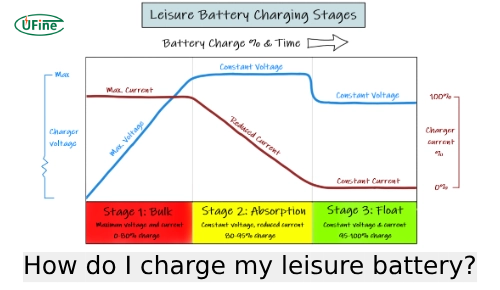A leisure battery is crucial in powering various appliances and devices while on the go, whether during a camping trip or in a recreational vehicle. Understanding how to charge your leisure battery properly is essential to ensure it remains fully charged and ready to power your adventures. This article will explore the different charging methods and battery charging stages and provide valuable tips for efficient leisure battery charging.
Part 1. How do I charge my leisure battery?
Charging a leisure battery involves a series of stages that allow it to regain its total capacity. Understanding these stages will help you charge your battery effectively and extend its lifespan.
Battery Charging Stages
Stage 1: Bulk Charging
The bulk charging stage is the initial phase, where a constant current is supplied to the battery until it reaches around 80% of its capacity. During this stage, the battery absorbs energy rapidly.
Stage 2: Absorption Charging
The charger switches to the absorption charging stage once the battery reaches around 80% capacity. In this stage, the charging voltage remains constant while the current gradually decreases. The battery continues to absorb energy and reaches nearly 100% capacity.
Stage 3: Float Charging
Once the battery reaches full charge, the charger switches to the float charging stage. During this stage, a lower voltage is applied to the battery to maintain its charge without overcharging. It prevents the battery from losing its charge while connected to a power source for an extended period.
Part 2. Charging methods for leisure batteries
You have a few options when it comes to keeping your leisure batteries juiced up.
Traditional Mains Charging:
Plugging your leisure batteries into a mains charger is the simplest method. These chargers come in various sizes and speeds, so choose one that suits your battery type and capacity. Just connect the charger to your battery, following the manufacturer’s instructions, and let it do its thing.
Solar Power:
Harnessing the sun’s power is a fantastic way to keep your batteries topped up, especially if you’re off-grid. Solar panels come in all shapes and sizes, from small portable ones to larger fixed installations. Position your panels where they’ll get plenty of sunlight, connect them to a charge controller, and then hook up your batteries. It’s clean, green, and free energy!
Generator Charging:
A generator can come in handy if you’re camping in a remote location or need a quick top-up. Fire it up, plug in your charger, and let it do its job. Generators can be noisy and emit fumes, so ensure you use them in well-ventilated areas and respect local regulations.
Vehicle Charging:
If you’re moving moving, you can use your vehicle’s alternator to charge your leisure batteries while driving. This convenient method can help ensure your batteries stay topped up, especially on longer journeys. Ensure your vehicle’s charging system is up to the task, and use a suitable charging cable.
Part 3. Leisure battery charging tips
Here are some simple tips to make sure you’re getting the most out of your battery charging:
- Regular Charging: Make it a habit to charge your leisure batteries regularly, even if you last used them a while ago. This helps prevent them from losing their charge and ensures they’re ready to go when you need them.
- Avoid Overcharging: Overcharging can damage your batteries and reduce their lifespan. Use an automatic shut-off feature or an intelligent charger that stops charging when the battery is complete to prevent overcharging.
- Check Voltage Levels: Invest in a voltmeter or multimeter to regularly monitor your batteries’ voltage levels. A fully charged leisure battery should have a voltage reading of around 12.6 to 12.8 volts.
- Maintain Proper Connections: Ensure the connections between your batteries and chargers are clean and secure. Dirty or loose connections can cause charging inefficiencies and potentially damage your batteries.
- Charge in a Well-Ventilated Area: When charging your batteries, do so in a well-ventilated area to prevent the buildup of potentially hazardous gases. Avoid charging batteries in enclosed spaces or near flammable materials.
- Consider Temperature: Extreme temperatures can affect battery performance and charging efficiency. Try to charge your batteries at temperatures between 50°F and 85°F (10°C to 30°C) for optimal results.
Part 4. Leisure battery charging monitoring
Monitoring the charging process of your leisure battery is essential to ensure its longevity and reliable performance. Here are some different monitoring methods and tools you can use:
Battery Monitors:
Battery monitors are dedicated devices that provide real-time information about your battery’s state of charge, voltage, and capacity. These monitors typically feature easy-to-read displays and can be installed directly onto your battery or charging system for continuous monitoring.
Intelligent Chargers:
Many modern battery chargers come with built-in monitoring capabilities. These smart chargers automatically adjust the charging rate based on the battery’s condition and provide status updates throughout the charging process. Some models even offer smartphone connectivity, allowing you to monitor your battery remotely.
Voltage Meters:
Voltage meters, also known as voltmeters or multimeters, are versatile tools that measure the voltage of your battery. By periodically checking the voltage readings, you can assess the state of charge and health of your battery. Voltage meters come in analog and digital varieties, with digital meters often offering greater accuracy and ease of use.
Battery Hydrometers:
You can use a hydrometer to measure the specific gravity of the electrolyte in lead-acid batteries, providing insight into their state of charge and health. By sampling the electrolyte from each cell and comparing the specific gravity readings to a reference chart, you can determine if the battery requires charging or maintenance.
Temperature Sensors:
Monitoring the temperature of your battery during the charging process is crucial for preventing overheating and damage. Temperature sensors, built into the battery or externally attached, can alert you if the battery temperature exceeds safe limits, allowing you to take corrective action.
Data Logging Systems:
Advanced monitoring systems can record and log data about your battery’s charging history over time. These systems may include software interfaces for analyzing the data and identifying trends or abnormalities. Reviewing the logged data, you can fine-tune your charging strategy for optimal performance and longevity.
Part 5. FAQs
-
What is the best way to charge a leisure battery?
The best way to charge a leisure battery is by using a dedicated charger that provides direct current (DC) power. Manufacturers design these chargers to deliver the correct voltage and charging profile for leisure batteries, ensuring safe and efficient charging. Alternating current (AC) chargers, such as those used for household appliances, are unsuitable for charging leisure batteries as they may need to provide the appropriate charging profile, potentially leading to damage or reduced battery lifespan. -
What percentage should I charge my leisure battery?
It’s best to charge your leisure battery to 100% whenever possible. However, if you’re using the battery regularly, charging it to at least 80% can help prolong its lifespan and maintain optimal performance. -
Can you charge a leisure battery with a standard car charger?
While charging a leisure battery with a standard car charger is possible, experts do not recommend it. Car chargers are designed for starting batteries and may not provide the correct charging profile for leisure batteries, potentially causing damage or reducing lifespan. -
Do you have to disconnect a leisure battery to charge it?
Disconnecting a leisure battery before charging is not always necessary, but it’s a good safety practice. Disconnecting the battery reduces the risk of accidental short circuits or damage to the charging system. -
How long should you charge a leisure battery?
The charging time for a leisure battery depends on several factors, including its capacity and the charging rate of the charger. Generally, it’s best to charge the battery slowly over a more extended period to prevent overheating and ensure thorough charging. -
How do you know when a leisure battery is fully charged?
You can determine when a leisure battery is fully charged by monitoring its voltage and using a battery monitor. When the battery reaches its maximum voltage and the charging current drops to a low level, it is likely fully charged. -
How do I stop my leisure battery from overcharging?
To prevent overcharging, use an automatic shut-off feature or an intelligent charger that adjusts the charging rate based on the battery’s condition. Additionally, avoid leaving the battery connected to the charger for extended periods after it reaches full charge.
Related Tags:
More Articles

Comprehensive Guide to Choosing the Right Cart Battery
Choosing the right cart battery ensures optimal performance and longevity. This guide covers cart battery types and helps you make an informed choice.
The Ultimate Guide to 18650 Button Top Battery
18650 button top batteries are popular for their high energy density and reliability. This guide covers their key features, usage, and maintenance tips.
The Power of Slim: Unveiling the Potential of Flat Lithium Ion Battery
Flat lithium-ion batteries power devices from phones to vehicles. This article explores their design, benefits, types, applications, charging, and safety.
The Comprehensive Guide to Battery Balancing and Battery Balancer
Battery balancing and balancers optimize performance, longevity, and safety. This guide covers techniques and tips for choosing the right balancer.
10 Key Facts About Drone Battery for 2024
Uncover crucial insights with "10 Key Facts About Drone Battery for 2024." Learn the latest trends and essential details on drone batteries.




